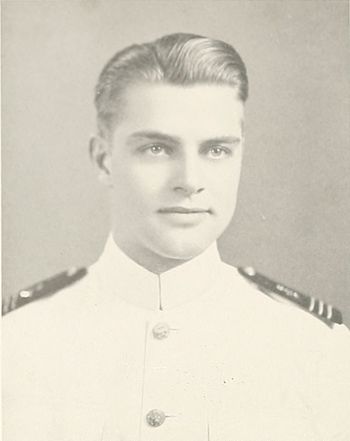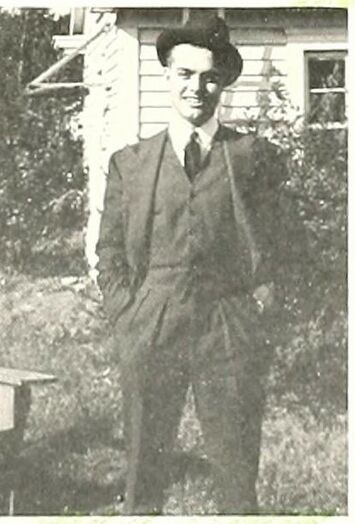RICHARD F. HOFER, LCDR, USN
Richard Hofer '42
Lucky Bag
From the 1942 Lucky Bag:
RICHARD FREDERICK HOFER
Falls City, Nebraska
Hof, Dick
Three years and we have yet to fathom the depths of Dick's supply of life's essentials: toothpaste, razor blades, and humor. Besides these, there is an additional wealth of good stories and an atmosphere of geniality which makes the Hof welcome in any outfit. A practical mind, lots of common sense, and the ability to think quickly complete the picture of a perfect roommate and needless to say a fine officer.
Boxing 4, b42t;; Battalion Boxing; Lacrosse 4; 2 Stripes.
The Class of 1942 graduated on December 19, 1941, less than two weeks after the United States entered World War II. The class had previously been scheduled to graduate in February 1942.

RICHARD FREDERICK HOFER
Falls City, Nebraska
Hof, Dick
Three years and we have yet to fathom the depths of Dick's supply of life's essentials: toothpaste, razor blades, and humor. Besides these, there is an additional wealth of good stories and an atmosphere of geniality which makes the Hof welcome in any outfit. A practical mind, lots of common sense, and the ability to think quickly complete the picture of a perfect roommate and needless to say a fine officer.
Boxing 4, b42t;; Battalion Boxing; Lacrosse 4; 2 Stripes.
The Class of 1942 graduated on December 19, 1941, less than two weeks after the United States entered World War II. The class had previously been scheduled to graduate in February 1942.
Loss
Richard was lost on July 7, 1952 when the plane he was aboard crashed near Albuquerque, New Mexico.
Other Information
From researcher Kathy Franz:
Richard was based at Sanford Naval Air Base in Florida when his plane crashed near Albuquerque. All six aboard the two engine JRF-5 Navy amphibian plane were killed. The plane was en route from Wichita Falls, Texas, to Kirtland air force base in Florida. It crashed across the top of the Sandia Mountains near the La Madera Ski Run.
Richard was born in Lincoln Township, Iowa. At age 10, Richard attended the Grand Avenue school, east of Humboldt. He lived with his grandfather William Estel at the time. He then attended Falls City schools and Kemper Academy at Booneville, Missouri.
He served on the destroyer, USS Edison, in the invasion of North Africa, Sicily and Italy. He received his wings at Pensacola in 1945.
He married Jane Lipscomb on January 24, 1951, at Emmanuel Episcopal Church in Franklin, Virginia.
He was survived by his wife and mother; he has a memory marker in Arlington National Cemetery.
Photographs
Remembrance
From Daileyint.com:
I would like first to highlight three individuals from two events of human valor. I do this because their outstanding performance was never officially recognized by the United States Navy.
First event. Richard Hofer, Class of 1942 U.S. Naval Academy, graduated from that institution in December 1941 just six months before I did in June 1942. Dick was at the Academy for three and one half years and I was there for three years, as our military training academies ramped up for war. Dick reported to the USS Edison, DD-439, six months before I arrived for duty on that ship in July 1942.
We bunked together in a stateroom just forward of the officer's mess. We served together for Casablanca, Sicily, Salerno and Anzio. He became Edison's Gunnery Officer after Sicily, and as told in my book at upper left, was one of Edison's team of four officers, three on the bridge with Dick in the Gun Director, who fought the ship at Salerno, where Edison and the cruiser USS Philadelphia together, in mine-infested inshore waters, kept the Tiger tanks of Kesselring's Army from enfilading and annihilating our U.S. Army landing forces at Paestum, Italy, on D-day!
But, it is earlier in the book when I learned of the capabilities of Dick Hofer. It was my first convoy out of Halifax NS. A convoy so important that a whole squadron of destroyers, nine in all, of DesRon 13, was assigned as escorts around the convoy, whose ocean escorts included the heavy firepower of USS Philadelphia and the battleship USS New York. On the first night out of Halifax, Convoy AT-20 encountered fog! In little swirls. In and out. In and out. The convoy was closed up tight and the ships behind the front column were keeping station not on the ship ahead, but on a towing spar streamed by that ship!
I will leave out essential detail included in the book to briefly note that USS Buck DD-420, was ordered to deliver a change of course message to the ship in convoy with the Convoy Commodore aboard. Buck attempted to cross the port column of Convoy AT-20 between the lead ship in that column and the second ship on the column. The second ship, the troop transport Awatea carrying 5,000 Canadian troopers, could not avoid cutting off the stern of the USS Buck! A tragic loss of the men in Buck's after steering engine room was one result but that only led to a much more severe tragedy.
That later tragedy occurred when the USS Ingraham DD-444, almost on an opposite course to investigate a 'collision in the convoy,' was hit by the Navy tanker USS Chemung. Ingraham was sliced in two as it exploded, sank immediately, with only eight survivors!
I was on the bridge of the USS Edison to relieve Dick Hofer as Junior Officer of the Deck underway. We observed the flash of the Ingraham's explosion as she sank. We did not know at that moment what had happened as our station in the convoy was on the opposite side of the convoy where the two collisions had occurred. Dick had just relayed to me that the TBS voice speaker on our bridge had just received from the Task Force Commander 's station on the USS Philadelphia a message to the Ingraham: "There has been a collision in the convoy. Close the convoy at high speed and investigate."
The facts as determined later from a Court of Inquiry attended by Chemung officers, determined from the latter's testimony that the Ingraham was making a much higher speed of advance than the fog conditions would have supported. Dick Hofer then provided me, in my first JOOD watch underway, in my first enemy waters night at sea in World War II, a thorough briefing prelude to a mid-watch full of events, any one of which would have been enough for a lifetime! Franklyn E. Dailey, Jr.

The "category" links below lead to lists of related Honorees; use them to explore further the service and sacrifice of alumni in Memorial Hall.
